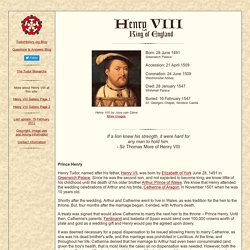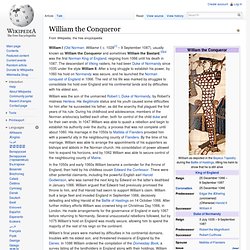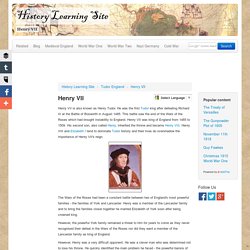

Henry VII of England. Henry VIII. If a lion knew his strength, it were hard for any man to hold him. - Sir Thomas More of Henry VIII Prince Henry Henry Tudor, named after his father, Henry VII, was born by Elizabeth of York June 28, 1491 in Greenwich Palace.

Since he was the second son, and not expected to become king, we know little of his childhood until the death of his older brother Arthur, Prince of Wales. We know that Henry attended the wedding celebrations of Arthur and his bride, Catherine of Aragon, in November 1501 when he was 10 years old. Shortly after the wedding, Arthur and Catherine went to live in Wales, as was tradition for the heir to the throne. A treaty was signed that would allow Catherine to marry the next heir to the throne -- Prince Henry.
It was deemed necessary for a papal dispensation to be issued allowing Henry to marry Catherine, as she was his dead brother's wife, and this marriage was prohibited in Leviticus. The marriage still did not take place however. John, King of England. John (24 December 1166 – 19 October 1216), also known as John Lackland (Norman French: Johan sanz Terre),[1] was King of England from 6 April 1199 until his death in 1216.

Following the battle of Bouvines, John lost the duchy of Normandy to King Philip II of France, which resulted in the collapse of most of the Angevin Empire and contributed to the subsequent growth in power of the Capetian dynasty during the 13th century. The baronial revolt at the end of John's reign led to the sealing of the Magna Carta, a document sometimes considered to be an early step in the evolution of the constitution of the United Kingdom. John, the youngest of five sons of King Henry II of England and Eleanor of Aquitaine, was at first not expected to inherit significant lands. Following the failed rebellion of his elder brothers between 1173 and 1174, however, John became Henry's favourite child. He was appointed the Lord of Ireland in 1177 and given lands in England and on the continent. Early life[edit] William the Conqueror. William I (Old Norman: Williame I; c. 1028[1] – 9 September 1087), usually known as William the Conqueror and sometimes William the Bastard,[2][a] was the first Norman King of England, reigning from 1066 until his death in 1087.

The descendant of Viking raiders, he had been Duke of Normandy since 1035 under the style William II. After a long struggle to establish his power, by 1060 his hold on Normandy was secure, and he launched the Norman conquest of England in 1066. The rest of his life was marked by struggles to consolidate his hold over England and his continental lands and by difficulties with his eldest son. In the 1050s and early 1060s William became a contender for the throne of England, then held by his childless cousin Edward the Confessor. There were other potential claimants, including the powerful English earl Harold Godwinson, who was named the next king by Edward on the latter's deathbed in January 1066. Background Early life. Henry VII. Henry VII is also known as Henry Tudor.

He was the first Tudor king after defeating Richard III at the Battle of Bosworth in August 1485. This battle saw the end of the Wars of the Roses which had brought instability to England. Henry VII was king of England from 1485 to 1509. His second son, also called Henry, inherited the throne and became Henry VIII. Henry VIII and Elizabeth I tend to dominate Tudor history and their lives do overshadow the importance of Henry VII's reign. The Wars of the Roses had been a constant battle between two of England's most powerful families - the families of York and Lancaster. However, the powerful York family remained a threat to him for years to come as they never recognised their defeat in the Wars of the Roses nor did they want a member of the Lancaster family as king of England.
However, Henry was a very difficult opponent. Henry had a three-way plan to bring the barons under his control. First, he banned all private armies. MLA Citation/Reference.